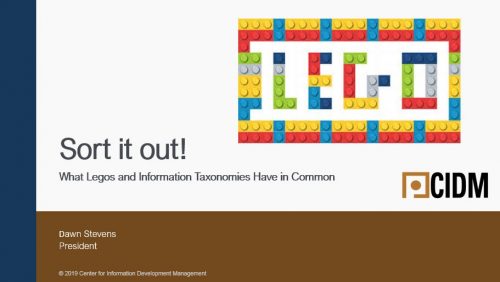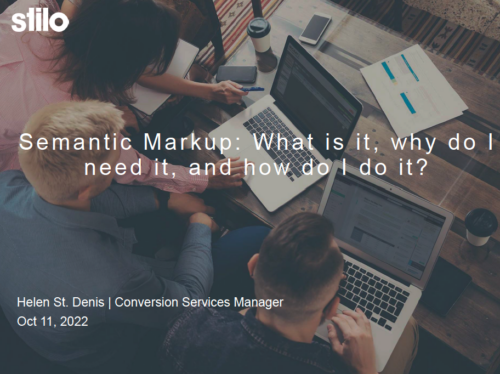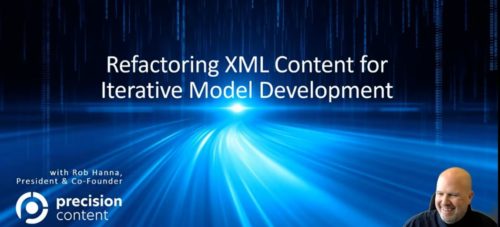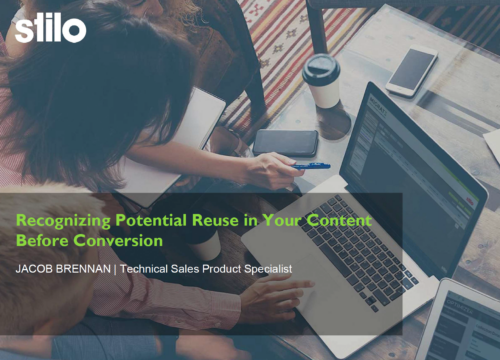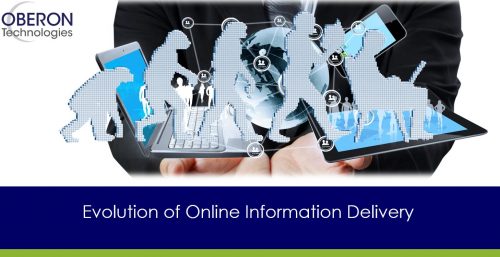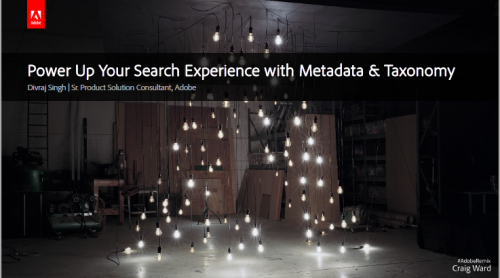-
August 28, 2019 Looking for a single piece of content on a web site is often compared to digging in a giant bucket of LEGOs for a single unique piece – an often frustrating and futile endeavor. If those LEGOs are sorted by certain distinguishing attributes, such as color and size, the odds of finding a particular piece increase dramatically. As a result, companies often take a “LEGO-block” approach to their information taxonomies. However, the sorting of LEGO blocks is child’s play, compared to the intricacies of sorting technical content – the distinctions are not always as visible as color or size, and attributes that are that obvious may not be very useful in a search. Nevertheless, there are lessons we can learn from the “LEGO-block” approach. In this session, Dawn draws parallels between sorting LEGOs and sorting technical content, and provides suggestions for going deeper when the Lego model falls short. Presented by: Dawn Stevens is the President, and owner of Comtech Services and the Director of the Center for Information-Development Management. With over 25 years of experience, including 15 years at Comtech, Dawn has practical experience in virtually every role within a documentation and training department, including project management, instructional design, writing, editing, and multimedia programming. With both engineering and technical communication degrees, Dawn combines a solid technical foundation with strong writing and design skills to identify and remove the challenges her clients face in producing usable, technical information and training.
-
Recorded on October 11, 2022

In the past, we have produced documents with a focus on how they look when published. Page layout, font face, font size, bolding and italics have been useful not just to make the documents attractive, but more importantly, to make them easier to read and understand. Nowadays we are told that semantic markup is preferable. Why is that, and how do we add it to our docs?
Presented by: Helen St. Denis
 Helen joined Stilo as a technical editor. She now works closely with Stilo Migrate customers, helping them to analyze their legacy content and configure appropriate mapping rules. She also provides Migrate customer training and support. Helen has helped Migrate customers to convert millions of pages of content to DITA and custom XML. Helen holds a Bachelor of Arts in English from St. Francis Xavier University in Antigonish, Nova Scotia, and has pursued graduate studies at Queen’s University in Kingston, Ontario. Email: [email protected] LinkedIn: https://www.linkedin.com/in/helen-st-denis-b1b60214/
Helen joined Stilo as a technical editor. She now works closely with Stilo Migrate customers, helping them to analyze their legacy content and configure appropriate mapping rules. She also provides Migrate customer training and support. Helen has helped Migrate customers to convert millions of pages of content to DITA and custom XML. Helen holds a Bachelor of Arts in English from St. Francis Xavier University in Antigonish, Nova Scotia, and has pursued graduate studies at Queen’s University in Kingston, Ontario. Email: [email protected] LinkedIn: https://www.linkedin.com/in/helen-st-denis-b1b60214/ -
Recorded: May 17, 2022
 While product cycles are getting shorter in all industries, down to daily releases for SaaS vendors, technical documentation teams have to keep up with the pace. Information needs to be written faster and delivered in sync.
Join Fabrice Lacroix, CEO and founder of Fluid Topics, and Gaspard Bébié-Valérian, certified technical writer and functional consultant, as they untangle the complex process of continuous content delivery and unveil new methods and processes to embrace the new landscape of documentation. They will share their insights and experience as they explore the collaborative potential between SMEs and tech writers opened by Docs as Code, examine the tooling behind a continuous documentation flow, and showcase the example of a robot writing release notes.
Presented by Fabrice Lacroix & Gaspard Bébié-Valérian:
Fabrice Lacroix is a serial entrepreneur and a technology pioneer. He has been working for 25 years on the development of innovative solutions around search technology, content enrichment and AI. He is the founder of Fluid Topics, the leading Content Delivery Platform that reinvents how users search, read and interact with technical documentation.
At the crossroads of engineering and social sciences, Gaspard enjoys exploring the breadth of technologies involved in technical documentation, including structured documentation, CCMS, and collaborative paradigms like docs as code. Gaspard works as Functional Consultant at Antidot helping clients get the most out of Fluid Topics.
While product cycles are getting shorter in all industries, down to daily releases for SaaS vendors, technical documentation teams have to keep up with the pace. Information needs to be written faster and delivered in sync.
Join Fabrice Lacroix, CEO and founder of Fluid Topics, and Gaspard Bébié-Valérian, certified technical writer and functional consultant, as they untangle the complex process of continuous content delivery and unveil new methods and processes to embrace the new landscape of documentation. They will share their insights and experience as they explore the collaborative potential between SMEs and tech writers opened by Docs as Code, examine the tooling behind a continuous documentation flow, and showcase the example of a robot writing release notes.
Presented by Fabrice Lacroix & Gaspard Bébié-Valérian:
Fabrice Lacroix is a serial entrepreneur and a technology pioneer. He has been working for 25 years on the development of innovative solutions around search technology, content enrichment and AI. He is the founder of Fluid Topics, the leading Content Delivery Platform that reinvents how users search, read and interact with technical documentation.
At the crossroads of engineering and social sciences, Gaspard enjoys exploring the breadth of technologies involved in technical documentation, including structured documentation, CCMS, and collaborative paradigms like docs as code. Gaspard works as Functional Consultant at Antidot helping clients get the most out of Fluid Topics. -
Recorded on April 5, 2023
 Let’s face it: the service technicians’ experience with technical documentation is not at all what you, knowledge and product teams, had expected. The latest Insight-Report Service* highlights the top pain points service teams face in their daily work with product documentation and uncovers sometimes-surprising learnings on what they really miss.
But this is not all bad news! Let’s tackle these issues and explore cutting-edge content strategies, tools, and solutions that can revolutionize the way your service technicians access and use technical documentation. You’ll discover how dynamic content delivery, truly mobile documentation, and AI-driven content recommendations can make a world of difference for your technicians’ productivity and satisfaction.
We will illustrate our point with real-world examples of how organizations have successfully implemented these strategies in record time to the benefit of their entire organization.
Join Christopher Rechtien, Innovation Manager at kothes, and Fabrice Lacroix, CEO of Fluid Topics, as they share practical insights and actionable takeaways to make your technical documentation the most useful and acclaimed resource for your service teams.
*The Insight-Report Service is a survey designed and conducted by kothes GmbH and supported by leading customer service associations in Europe.
Presented by Fabrice Lacroix, CEO of Fluid Topics and Christopher Rechtien, Innovation Manager at kothes
Let’s face it: the service technicians’ experience with technical documentation is not at all what you, knowledge and product teams, had expected. The latest Insight-Report Service* highlights the top pain points service teams face in their daily work with product documentation and uncovers sometimes-surprising learnings on what they really miss.
But this is not all bad news! Let’s tackle these issues and explore cutting-edge content strategies, tools, and solutions that can revolutionize the way your service technicians access and use technical documentation. You’ll discover how dynamic content delivery, truly mobile documentation, and AI-driven content recommendations can make a world of difference for your technicians’ productivity and satisfaction.
We will illustrate our point with real-world examples of how organizations have successfully implemented these strategies in record time to the benefit of their entire organization.
Join Christopher Rechtien, Innovation Manager at kothes, and Fabrice Lacroix, CEO of Fluid Topics, as they share practical insights and actionable takeaways to make your technical documentation the most useful and acclaimed resource for your service teams.
*The Insight-Report Service is a survey designed and conducted by kothes GmbH and supported by leading customer service associations in Europe.
Presented by Fabrice Lacroix, CEO of Fluid Topics and Christopher Rechtien, Innovation Manager at kothes
 Fabrice Lacroix is a serial entrepreneur and a technology pioneer. He has been working for 25 years on the development of innovative solutions around search technology, content enrichment and AI. He is the founder of Fluid Topics, the leading Content Delivery Platform that reinvents how users search, read and interact with technical documentation.
Fabrice Lacroix is a serial entrepreneur and a technology pioneer. He has been working for 25 years on the development of innovative solutions around search technology, content enrichment and AI. He is the founder of Fluid Topics, the leading Content Delivery Platform that reinvents how users search, read and interact with technical documentation. -
August 5, 2020 Abstract Business leaders around the globe are looking for ways to replicate the successes of innovative and disruptive organizations like Uber, Amazon, and Spotify that grow exponentially. Rather than adding 10%, they’re looking for 1000%. Exponential growth is deliberate and involves organizations developing capabilities that dramatically outperform the competition. Rob Hanna explores how information-enablement across the enterprise is key to this type of performance and why we need to rethink how we create content to become Exponential Organizations. What you’ll learn
- The definition of “information enablement”
- How your content is tied to your brand’s ability to grow exponentially
- How the 4th Industrial Revolution will impact global businesses, including yours
-
December 1, 2021 Developing robust content models can never be a once-and-done endeavor where IAs are required to incorporate all aspects into the design prior to authoring. Instead, an iterative approach is needed to allow for incremental improvements not just during setup but long into production. Join Precision Content’s President and Chief Information Architect, Rob Hanna, to explore methods the company uses to refine models and update the content corpus through scheduled refactoring activities. Presented by: Rob Hanna is an award-winning technical writer and content strategist and an industry leading expert in structured XML authoring, DITA, and content management. In 2014, Rob was awarded the rank of Fellow of the Society for Technical Communication (STC) and earned the Enterprise Content Management Specialist (ECMs) designation from AIIM. In 2017, he was named one of the top 25 global leaders in content experience strategy by Mind Touch. He founded Precision Content in 2013 after nearly 20 years in the industry as a technical writer, information architect, knowledge management specialist, and taxonomy expert. In 2018, Precision Content joined Google, Adobe, and Acrolinx on the list of "Top 100 Companies that Matter Most in Digital Content Industry" by EContent Magazine. See http://www.linkedin.com/in/singlesourceror for more information.
-
Recorded on December 1, 2022
 One of the main benefits of using a structured format such as DITA is the ability to reuse content, but realizing where reuse is beneficial and estimating the probable savings can be a tedious and time-consuming task. In this webinar, we demonstrate how you can identify reusable or redundant content in your own documentation and pinpoint potential cost savings using detailed graphical reports with Stilo’s Analyzer.
Presented by Jacob Brennan
One of the main benefits of using a structured format such as DITA is the ability to reuse content, but realizing where reuse is beneficial and estimating the probable savings can be a tedious and time-consuming task. In this webinar, we demonstrate how you can identify reusable or redundant content in your own documentation and pinpoint potential cost savings using detailed graphical reports with Stilo’s Analyzer.
Presented by Jacob Brennan
 Jacob Brennan is a Technical Sales Product Specialist at Stilo. He works with Stilo Migrate customers and aids in converting their legacy content to DITA. Jacob is a recent graduate from the University of Ottawa holding a BASc. in Mechanical Engineering and a BSc. in Computing Technology.
Jacob Brennan is a Technical Sales Product Specialist at Stilo. He works with Stilo Migrate customers and aids in converting their legacy content to DITA. Jacob is a recent graduate from the University of Ottawa holding a BASc. in Mechanical Engineering and a BSc. in Computing Technology. -
Recorded on January 11, 2024

There are many different situations when you might convert content from one form into another, from a one-off migration project, converting everything from a legacy format into an open XML standard, all the way to regularly converting third-party content to bring it into your internal CMS. The tools used to convert vary. Maybe you’re using a vendor to convert content for you, or perhaps you wrote your own XSLT suite, which you manage in-house. Whichever route you take and whatever the purpose of your conversion, there is always a risk that content may be lost or corrupted during conversion. In this webinar, Tristan from DeltaXML will walk through some of the pitfalls of content conversion and show how their new tool, ConversionQA, can help you ensure that your content conversion hasn’t misplaced a single character.
Presented by: Tristan Mitchell, DeltaXML Tristan is Product Director at DeltaXML, a technology company with world-leading software products for the management of change in structured content. He has a deep understanding of DeltaXML’s product suite and loves to help customers create extra value in their content using change management. Tristan is a father to three daughters, a movie lover, and a keen runner.
Tristan is Product Director at DeltaXML, a technology company with world-leading software products for the management of change in structured content. He has a deep understanding of DeltaXML’s product suite and loves to help customers create extra value in their content using change management. Tristan is a father to three daughters, a movie lover, and a keen runner.
-
Recorded on November 16, 2022

Multilingual content is fundamental for successful communication with other people, cultures, and markets. Naturally, the quality of translations is of central importance. Often, these quality assurance processes are unsystematic and rely on spontaneous “feedback” from in-country reviewers. However, more often than not, these review processes lead to long waiting times, frustrating discussions, no real process improvements, and thus impede strategic and sustainable language quality management.
We share how
- to define translation quality
- to measure translation quality
- to involve and instruct all stakeholders
- to manage translation quality actively and sustainably
Join us to learn which aspects and stakeholders you need to take into consideration on your way to successful quality management of multilingual content.
Presented by Klaus Fleischmann Klaus Fleischmann studied translation and IT in Vienna, holds an MA in Conference Interpreting from Monterey, California, and a MAS in Technical Communication from Krems, Austria. In 1996, he founded Austria-based Kaleidoscope, a company implementing content, translation, and terminology management processes for internationally active companies. Kaleidoscope develops online collaboration software for enterprise-level terminology workflow, translator query management, in-country review etc., making the translation quality process comprehensible and strategically manageable. In 2007, he became CEO of Austria´s leading LSP, Eurocom Translation Services. Always active in the industry, Klaus got voted into the Gala Board of Directors in 2015 and 2017.
Klaus Fleischmann studied translation and IT in Vienna, holds an MA in Conference Interpreting from Monterey, California, and a MAS in Technical Communication from Krems, Austria. In 1996, he founded Austria-based Kaleidoscope, a company implementing content, translation, and terminology management processes for internationally active companies. Kaleidoscope develops online collaboration software for enterprise-level terminology workflow, translator query management, in-country review etc., making the translation quality process comprehensible and strategically manageable. In 2007, he became CEO of Austria´s leading LSP, Eurocom Translation Services. Always active in the industry, Klaus got voted into the Gala Board of Directors in 2015 and 2017. -
October 9, 2019 Delivering a cCMS solution on time and on budget is critical, but it’s important to recognize that the cCMS is only one part of a successful content lifecycle strategy. Making sure your content can be leveraged across the enterprise and your system will be able to support future initiatives requires a comprehensive and proven plan. Having led hundreds of successful content solution implementations, Oberon understands the differences in the tools, processes and environments that must be considered. While each cCMS implementation plan may be unique, shaped by the specific needs of a given company, there are many common steps to success that everyone should follow. Whether you are looking to adopt cCMS for the first time or you’ve been using one for years, there are ways to ensure your system is optimized for success. Attend this webinar and find out what your plan should include. Presented by: Vi Kellersohn is the Chief Marketing Officer of Oberon Technologies. Vi leads the marketing efforts, manages strategic partnerships and supports key client projects. For over 20 years Vi has managed and executed all aspects of marketing for B2B technology organizations working in partnership with sales management to build awareness for value opportunities across the content lifecycle. Vi enjoys spending time with her extended family and golfing with her husband and two sons.
-
May 21, 2019 As technology advances so do consumer expectations for online information access. No longer do users want to rely on printed materials nor are we satisfied with views of lengthy PDFs online. Consumers, both inside and outside your organization, want to quickly find just the information they need from any device. With the emergence of many connected products, virtual and augment reality the online information demands can be staggering. Is your documentation system ready to take you into the future? Find out how many organizations are taking steps to delivering better information today and prepare their organization to more easily evolve with technology advances and consumer demands. Attendees will learn: 1) What does the evolution of online delivery include? 2) How structured content impacts your future delivery options? 3) Why you don’t have to wait to begin improving your users’ online delivery experiences? Presented by: Vi Kellersohn is the Chief Marketing Officer of Oberon Technologies. Vi leads the marketing efforts, manages strategic partnerships and supports key client projects. For over 20 years Vi has managed and executed all aspects of marketing for B2B technology organizations working in partnership with sales management to build awareness for value opportunities across the content lifecycle. Vi enjoys spending time with her extended family and golfing with her husband and two sons.
-
May 13, 2020 There is an explosion of content today. But what makes your content stand out is – relevance and searchability. To ensure that customers don’t have to spend hours searching through your content, metadata is key. And to know what metadata to add while authoring, a well-established taxonomy is key. To design a truly best-in-class content search experience metadata and taxonomy need to work in tandem. In this webinar we will showcase:
- How to leverage metadata to make your content searchable
- What is the difference between good and bad taxonomies
- A live example of taxonomy development using Adobe Experience Manager

